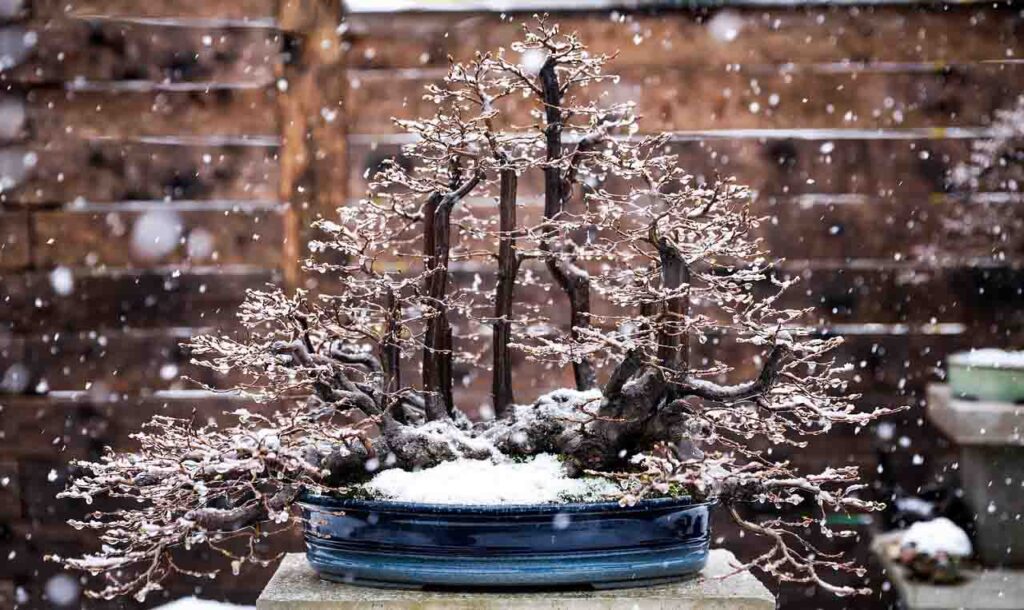
How do I keep my native bonsai in winter?
Claude Savard
CSCeramique
I have native trees, but how do I keep my native bonsai in Quebec winters? This is a common concern among many hobbyists. The fascinating world of bonsai appeals to many enthusiasts, but it can be a source of uncertainty for beginners, especially when it comes to winter survival. There's a common misconception that these small trees must be kept indoors during the cold season. On the contrary, they need to follow a hibernation cycle, similar to that of their big brothers, to maintain their health. In this article, we'll explore methods for preserving your bonsai trees in winter, taking into account Quebec's harsh climate. Translated with www.DeepL.com/Translator (free version)
Why protect our native bonsais in winter:
It's essential to recognize that bonsai from native trees have their own characteristics. If you have trees in this category in your collection, be sure to keep them outdoors all year round. They require winter protection to prevent damage from the harsh winter weather and undesirables (field mice/mice) from damaging your trees.
Some species, such as Larch (Larix laricina), are incredibly hardy and could survive without protection from the cold. However, it's vital to protect them from the vagaries of Quebec winters, characterized by sudden temperature variations ranging from -30 degrees Celsius to ice storms. These trees are vulnerable to these unpredictable conditions, and the loss of a branch or unwanted transformation of your bonsai after years of work can lead to deep disappointment, even discouragement. It's an experience I've had myself, and one that has prompted me to always protect even my hardiest bonsai.
How to protect native trees in winter:
There are many ways to preserve your bonsai, but we'll explore three of the most popular.
- Polystyrene cones:
If your collection is small, polystyrene cones can be a practical solution. It's best to bury the pots to protect the roots from frost. Use geotextile fabric to prevent soil from contaminating the substrate. - The wooden structure:
If you opt for a wooden structure, make sure it's strong enough to bear the weight of the snow. We generally use plywood to build this structure. To ensure optimum thermal stability, we insulate the interior using a rigid material. This minimizes rapid temperature fluctuations. - The carport:
The carport is another option, requiring the use of a geotextile protection fabric, covered with a tarpaulin to protect it from rain and water that could reduce its effectiveness.
We'll look at the specifications of each protection in more detail in this article.
How to protect bonsai pots in winter
Protecting your pots is of crucial importance, so make sure your pots are designed to be frost-resistant, consulting your potter if necessary. However, this step is primarily aimed at preserving your substrate, so we recommend carefully wrapping your bonsai pot in geotextile fabric. This will help prevent any contamination of your substrate by outside elements during the cold season.

To make this protection, take two pieces of geotextile fabric large enough to completely enclose your pot. Cut a notch in the center of each sheet.

Apply the first cloth to completely cover the substrate and pot. Then apply the second cloth in the opposite direction. The substrate and pot are now ready for burial.
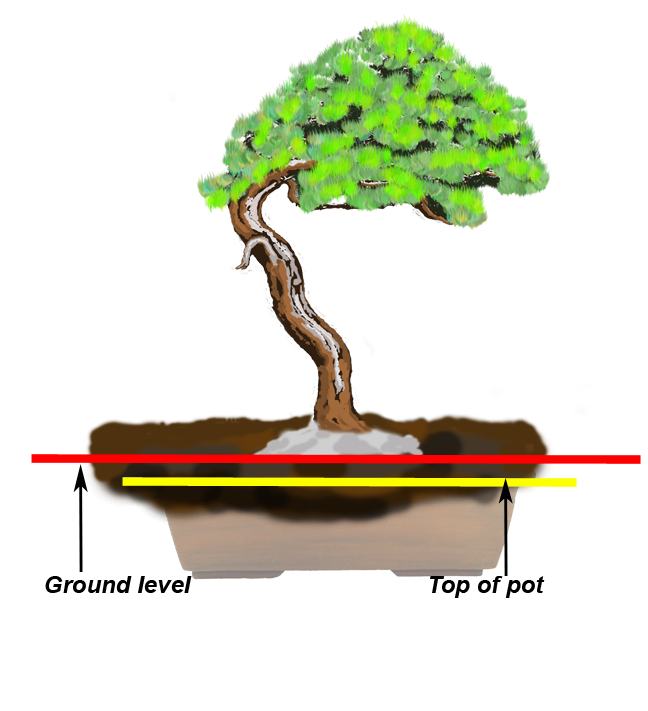
The next step is to bury your bonsai below ground level. It's crucial to press the soil down firmly to eliminate any gaps between your pot and the ground. By creating this close contact, your bonsai will constantly benefit from the moisture present in the soil, compensating for the absence of watering during the winter.
Making sure you leave only a few centimetres of soil on the surface of your pot, make sure you don't completely cover the base of the trunk. This is crucial to prevent excess humidity, which can lead to rotting of the trunk in some species.
Polystyrene cones:
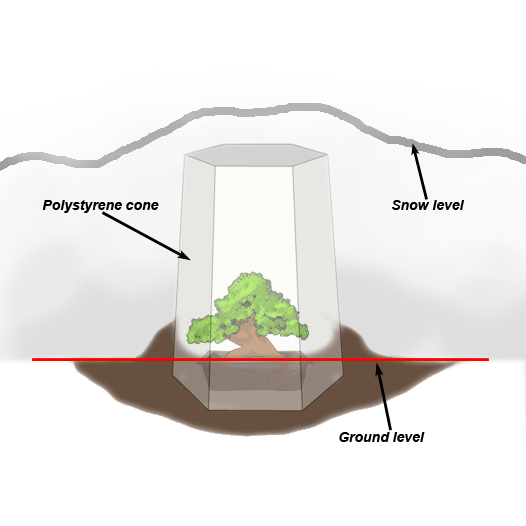
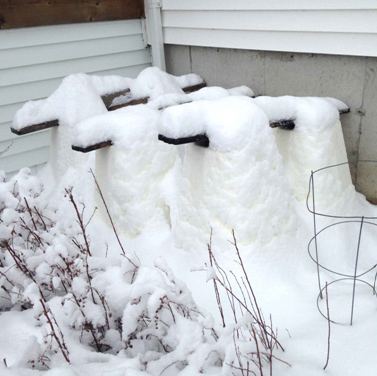
If you opt to protect your bonsai with polystyrene cones, it's crucial to follow the recommendation above, i.e. to bury your tree properly. However, under no circumstances should you introduce mulch, dead leaves or snow inside the cone. The reason for this is that these materials can retain excessive levels of moisture, encouraging the development of rot.
It's important to emphasize that effective protection against the cold depends solely on the snow on the outside of the cone. That's why it's essential to cover all your cones to guarantee optimum insulation for your trees.
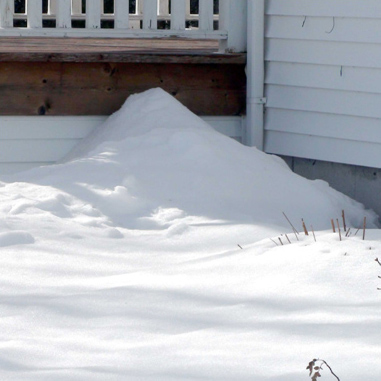
Be sure to bury the polystyrene cones completely under the snow, as it is this layer of snow that will act as insulation against extreme cold and temperature variations. Also, if possible, place your shelters on the north side of a structure or in areas with less sun exposure during the winter, as excessive sun exposure could cause undesirable temperature variations.
The wooden structure:
If your collection is bigger, the use of a wooden structure makes management considerably easier, offering the flexibility to adjust to the specific dimensions of your collection. In this case, you'll need to apply the same protective features as polystyrene cones are to bury your trees, without adding any other material inside.
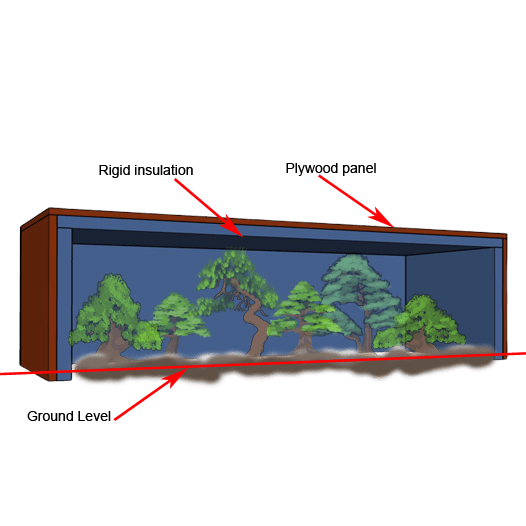
However, there is one small exception worth mentioning. If your box is not insulated with a rigid material, the use of snow can be considered to reinforce the insulation of your trees. On the other hand, if your protection is insulated, the addition of snow is not recommended. The reason for this restriction is that existing insulation already creates an environment with high humidity levels, and adding snow could accentuate this phenomenon.
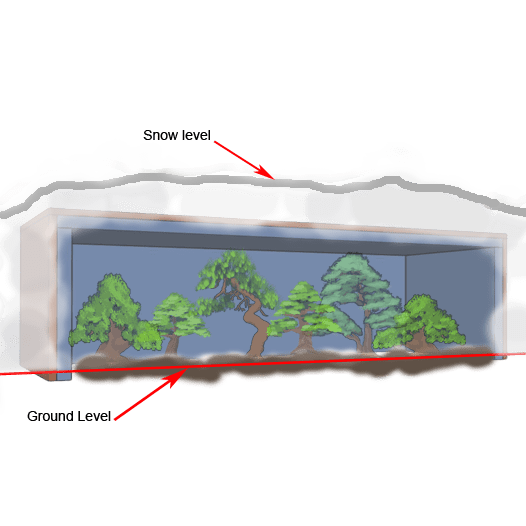
For the same reasons, we recommend burying your box under the snow. Snow remains the best insulator to prevent temperature variations inside your shelter, ensuring optimum protection for your trees.
The carport:
Protection with a carport is particularly useful, especially if you have a large collection of good-sized trees. The technique remains constant: whether you choose to bury your trees in the ground, it's still the best option. However, if burying your bonsai proves difficult, a viable solution is to simply place your trees on the ground. Then, the trick is to insert snow between them, creating a natural insulation.
You might wonder why this specific option operates here, unlike the previous two alternatives. In a carport, the air volume is adequate, and this protection is not hermetic. As a result, air circulates freely, allowing moisture to escape easily. This is a major distinction from the use of an insulated cone or box, which retains soil moisture.
Here are the steps I use to preserve my native trees during the cold seasons. In this structure, a few bonsais, prebonsais and trees in various stages of growth live side by side.
Note the two wooden structures, which will be connected by two galvanized steel tubes. These tubes will play a crucial role in supporting the geotextile fabric and tarpaulin. This arrangement is essential to avoid any unwanted contact with the tree foliage, thus preserving its integrity and preventing any possible damage.
The three steps to carport insulation:
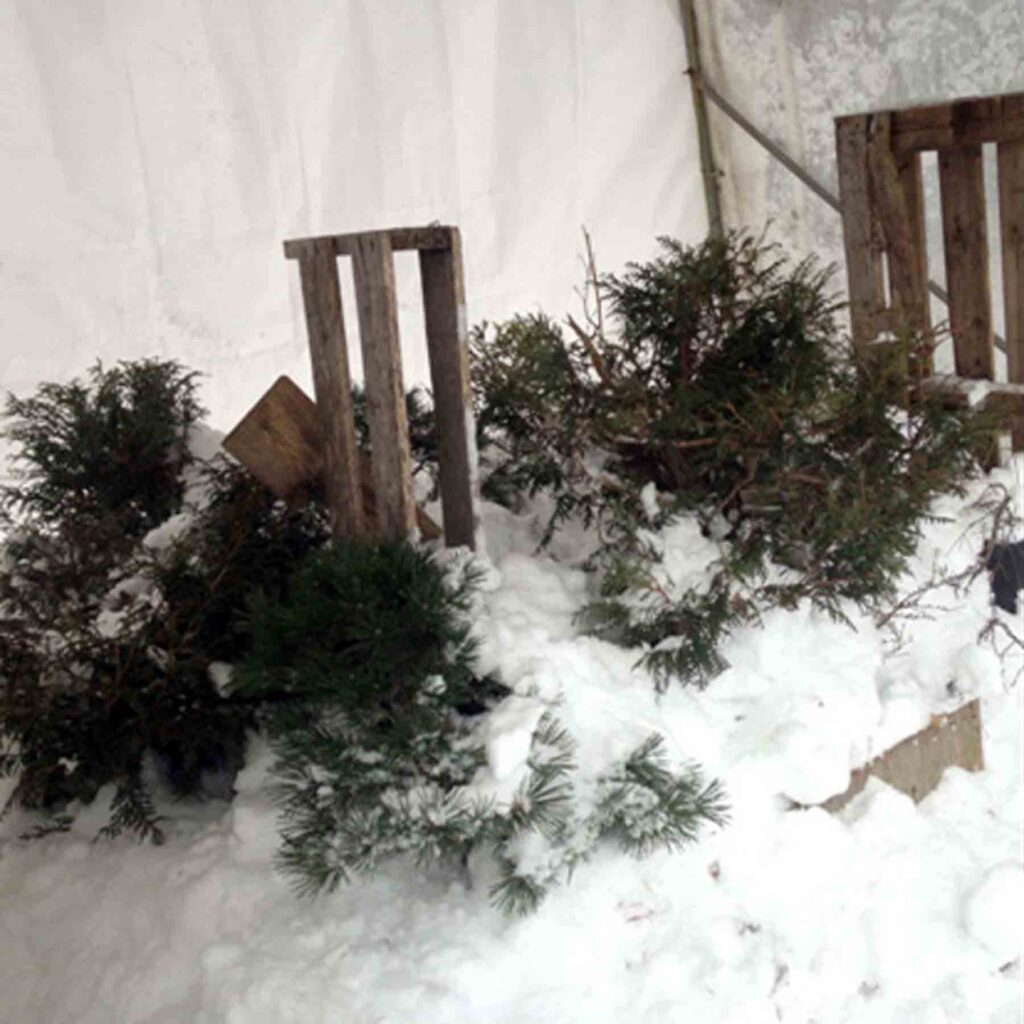
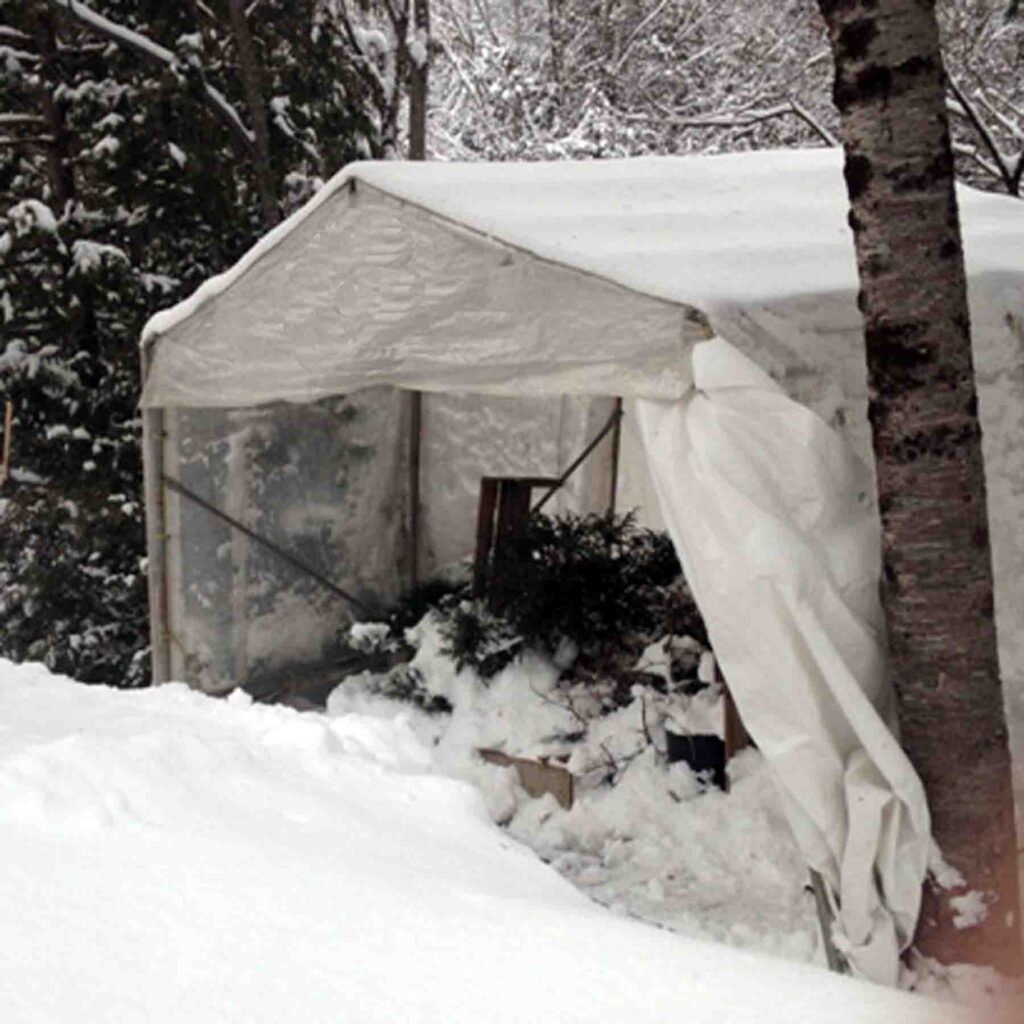
1. It's crucial to add a thick layer of snow between the trees, insulating them as much as possible from the extreme cold of Quebec winters.
Unlike other methods, where the snow cover on the structures serves as insulation, in this case the carports are regularly cleared of snow. This precaution prevents collapse under the weight of winter accumulation, ensuring optimum protection for my trees.
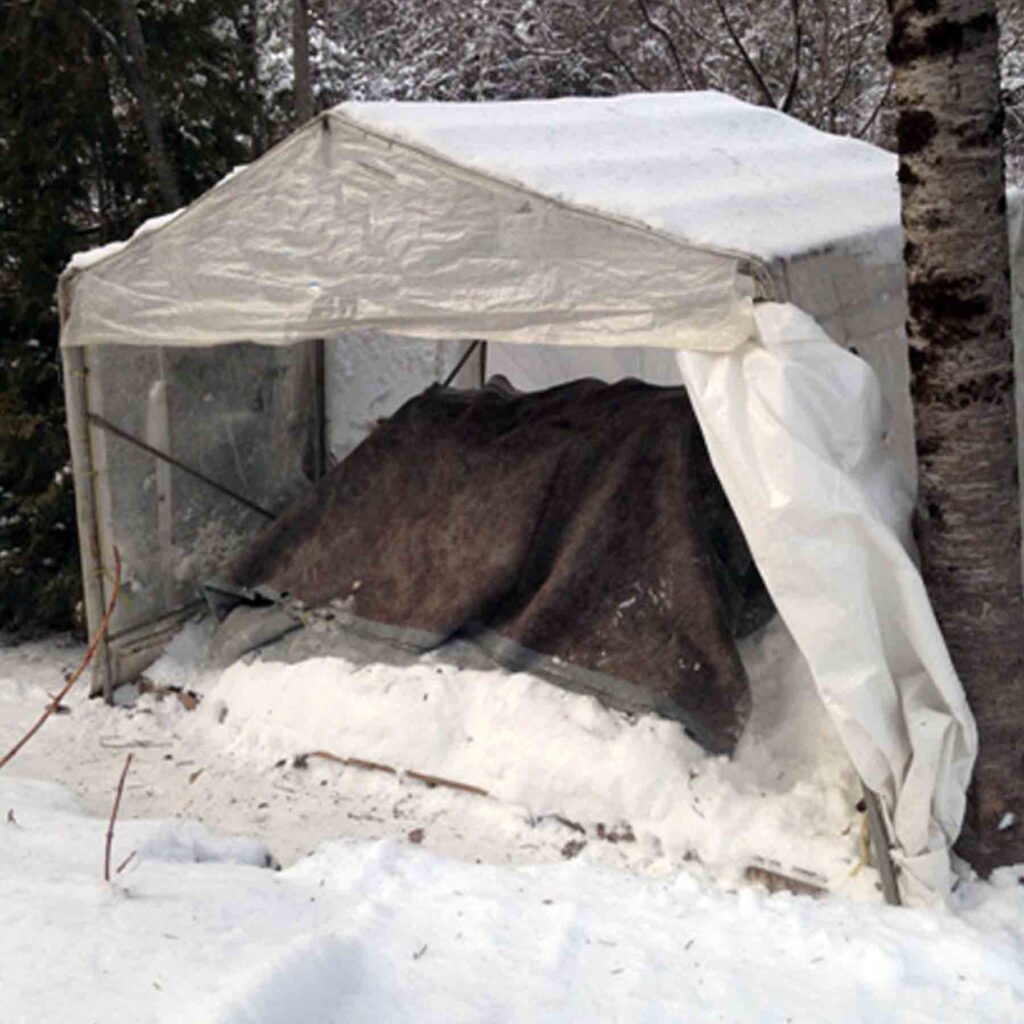
2. I carefully cover all my trees with geotextile fabric. Personally, I've opted to use an old swimming pool mat. This option has several advantages. Firstly, it's thicker, offering greater protection. What's more, it's sturdier than the materials usually found in garden centers for winter protection.
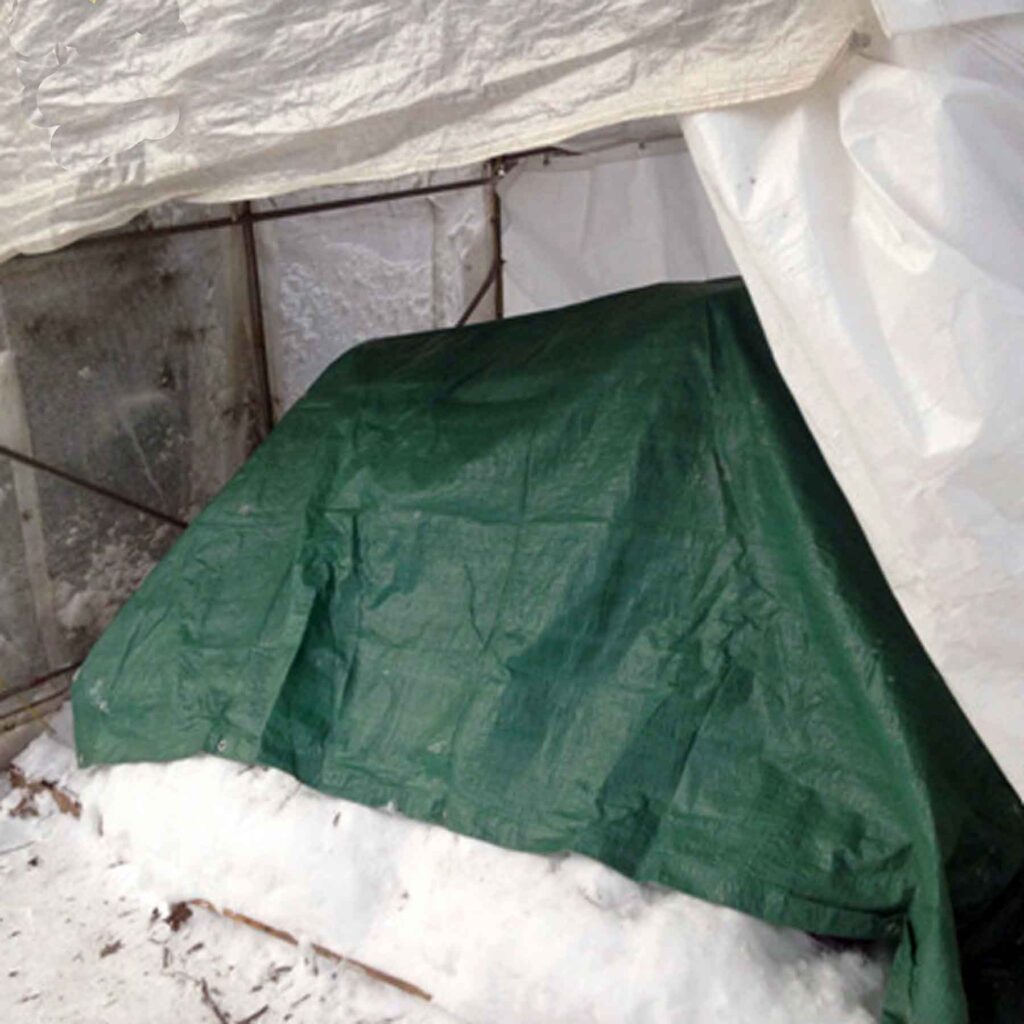
3. All you have to do now is place a tarpaulin over your geotextile cloth. This protection is essential in the event of winter rainfall, as the fabric will lose its insulating effectiveness if it gets wet.
In conclusion;
Winterizing bonsai is an essential process for preserving the health and aesthetics of these miniature trees. By adopting good practices, such as proper protection and maintenance of bonsai pots, you can ensure that your precious creations will survive the harsh Quebec winters. Thanks to these protective measures, your bonsai trees will continue to thrive and amaze you year after year.